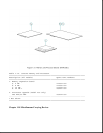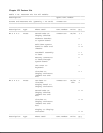
Chapter 2. Preparing the Computer for Service
Introduction
This chapter provides general service information necessary to prepare the
computer for service in the following areas:
o Electrostatic discharge
o Service preliminaries
o Battery disposal
Adherence to the procedures and precautions described in this chapter is
essential for proper service.
Chapter 2.1 Electrostatic Discharge
>>>>>>>>>>>>>>>>>>>>>>>>>>>>>>>>> CAUTION <<<<<<<<<<<<<<<<<<<<<<<<<<<<<<<<<
Static electricity can damage electronic components. Before beginning
these procedures, make sure you are grounded (discharged of static
electricity) by briefly touching a grounded, unpainted, metal object or
surface.
>>>>>>>>>>>>>>>>>>>>>>>>>>>>>>>>>>>>><<<<<<<<<<<<<<<<<<<<<<<<<<<<<<<<<<<<<<
A sudden discharge of static electricity from a finger or other conductor
can destroy static-sensitive devices or micro circuitry. Often the spark
is neither felt nor heard, but damage occurs. An electronic device exposed
to electrostatic discharge (ESD) may not be affected at all and will work
perfectly throughout a normal cycle. Or it may function normally for a
while, then degrade in the internal layers, reducing its life expectancy.
Networks built into many integrated circuits provide some protection, but
in many cases, the discharge contains enough power to alter device
parameters or melt silicon junctions.
This section details methods of generating, preventing, and grounding
static electricity.
Generating Static
Table 2-1 shows how different activities generate static electricity and
at different electrostatic voltage levels.
Table 2-1. Typical Electrostatic Voltages
===========================================================================
Relative Humidity
Event 10% 40% 55%
===========================================================================
Walking across carpet 35,000 V 15,000 V 7,500 V
Walking across vinyl floor 12,000 V 5,000 V 3,000 V


















